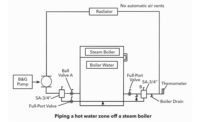Yes, but there is a limit to how much radiation you can support from your steam boiler.
Boiler manufacturers list two capacity outputs on every steam boiler. The first output is called the DOE (Department of Energy) capacity. It can also be referred to as the boiler’s gross output. The other rating is the boiler’s net capacity. The difference between these two capacities is about 33-1/3 percent.
Gross output, the higher of the two, includes capacity to pick-up the system when you first turn it on as well as the load of keeping the piping network warm. The net capacity is the available energy to heat the radiation and keep the house warm. Once the system has warmed up, the boiler has this extra 33-1/3 percent capacity available and this becomes the limiting factor for how much radiation can be supported for the hot water zone. You have the option of running the zone in a priority condition if the load is greater than the pick-up factor but this means no heat in the steam system while the hot water zone operates.
What keeps the water “up” in the piping and radiation?
Atmospheric pressure, which is pushing down on the water in the steam boiler, keeps the water “up” in the radiation. At sea level, the atmosphere is pushing down on everything with a pressure of 14.7 pounds per square inch. One pound of pressure per square inch can lift water 2.31 feet.
In theory, the atmosphere can support water to 34 feet but 30 feet is the practical limit. In a steam system, because atmospheric pressure is pushing the water up, you never should use any vents in the condensate zones off of the boiler because when a vent opens, the condensate will fall down into the boiler and flood it.

Click on the illustration for an enlarged view.
If you oversize your steam boiler, you’ll have all kinds of problems such as water hammer, surging water lines, and uneven heating. You’ll be “shoving” too much steam into a system that was designed for a lesser load.
How should I pipe the hot water zone off the steam boiler?
You should have the supply and return connections located below the water line of the boiler (see illustration). Ideally, they should be located so that there will be a good, cross-sectional flow of water through the boiler. This is to make sure the water doesn’t “short-circuit” through the boiler and not pick up enough Btu.
Also the circulator should be located on the supply side (below the water line of the boiler), pumping away from the boiler and out to the radiation so that all of the circulator’s pressure differential will be added to the system, not subtracted. This will help prevent the water from flashing into steam and causing water hammer.
Are there any other piping details to consider?
When piping the hot water zone off the boiler, you should pipe a bypass around the boiler to limit the temperature of the water that will circulate out to the radiation. When the boiler is producing steam, the water temperature is the same as the steam. At 1 psi of steam pressure, the water temperature will be 216°F, at 2 psi, the temperature is 218°F and so on. The problem with water being this hot is that, when the circulator shuts off because the zone is satisfied, there is a good chance that some of the water up in the zone will “flash” into steam.
Remember that there are no pressure-reducing valves in these types of systems. Therefore, the water at the top of the system is under no pressure. And since water can flash into steam at 212°F at zero psi whenever the circulator turns off, you can get “banging” in the hot water zone and a flooded steam boiler in the basement.
Reprinted with permission from the McDonnell & Miller/Hoffman Specialty newsletterCounterPoint™,Volume 11, Issue 1. For more information on steam systems, visit the McDonnell & Miller Website at www.mcdonnellmiller.com and the Hoffman Specialty Website at www.hoffmanspecialty.com.
Publication date:02/05/2007








